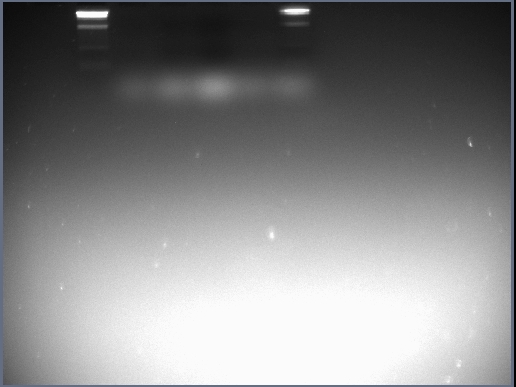Team:Newcastle/Labwork/4 September 2009
From 2009.igem.org
(→Results) |
|||
| Line 22: | Line 22: | ||
===Results=== | ===Results=== | ||
[[Image:Team Newcastle 2009 iGEM Geldoc 2009-09-04 16hr 52min.jpg|450px|center]] | [[Image:Team Newcastle 2009 iGEM Geldoc 2009-09-04 16hr 52min.jpg|450px|center]] | ||
| + | ==<u>Stochastic Switch Team</u>== | ||
| + | Today we ran the sac and ara PCR products from yesterday on an 0.8% agarose gel in order to determine whether they were worth using the clean up kit on. We ran two PCRs for each set of primers so that resulting fragments could be combined for a more successful ligation. As it happens there was a good result for the sac product but no fully clear bands for the ara product. However both PCR products for sac and ara were combined and the PCR clean up procedure was carried out according to the protocol. Following clean up a digest was done on both products using EcoRI and SpeI. This was done using the fast digest enzymes and buffer, however the reactions were left for an hour. | ||
| + | Rather than running these products on a wide well agarose gel the PCR clean up procedure was carried out to save time and avoid losing as much product. The resulting elutions were labaeeled and put into the -20 freezer in the midi-preps box. | ||
| + | |||
| + | Goksel carried out an ''E.coli'' transformation using the ligation product from yesterday (pSB1AT3 + sspb) however we are unsure whether the protocol used was appropriate for the ''E.coli'' strains used. For this reason on Monday we will try ligating all three fragments (sac, ara as well as sspb) with the pSB1AT3 backbone again. For this we will try the new Fast Ligation/Transformation kit to try to save time. | ||
| + | |||
{{:Team:Newcastle/Footer}} | {{:Team:Newcastle/Footer}} | ||
{{:Team:Newcastle/Right}} | {{:Team:Newcastle/Right}} | ||
Revision as of 18:31, 6 September 2009
Contents |
Lab Work 04/09/09
Promoter Library Sub-Project
Introduction
In yesterday's lab session the products from the PCR reactions on the C0, V1, V2 and V3 samples were purified. The gel electrophoresis carried out on the unpurified samples the previous day showed hazy bands however it was uncertain that these bands were the promoters or just primer-dimers. Today, we aim to carry out DNA gel electrophoresis on these purified samples (in 1.5% agarose gel) to determine whether any PCR amplification reactions worked.
Preparing samples and DNA Gel Electrophoresis
The purified PCR products were treated in a similar way to which DNA samples are treated in the gel electrophoresis protocol except 5ul of each sample was extracted and to each of these 1ul of loading buffer (dye) added. 15ul of HindIII' ladder will be added in the first and last wells of the 1.5% agarose gel. This is how the wells will be organised:
- Lane 1 = blank
- Lane 2 = 15ul of HindIII DNA ladder
- Lane 3 = 6ul of C0 (Sample 1)
- Lane 4 = 6ul of V1 (Sample 2)
- Lane 5 = 6ul of V2 (Sample 3)
- Lane 6 = 6ul of V3 (Sample 4)
- Lane 7 = 15ul of HindIII DNA ladder
The 1.5% agarose was prepared and poured in the same way as the DNA gel electrophoresis protocol suggests. The samples were then added to the wells in the way described above; the voltage was set to 60mv and left for 15-20 minutes. The photograph obtained from the resulting gel can be seen in the 'Results' section.
Results
Stochastic Switch Team
Today we ran the sac and ara PCR products from yesterday on an 0.8% agarose gel in order to determine whether they were worth using the clean up kit on. We ran two PCRs for each set of primers so that resulting fragments could be combined for a more successful ligation. As it happens there was a good result for the sac product but no fully clear bands for the ara product. However both PCR products for sac and ara were combined and the PCR clean up procedure was carried out according to the protocol. Following clean up a digest was done on both products using EcoRI and SpeI. This was done using the fast digest enzymes and buffer, however the reactions were left for an hour. Rather than running these products on a wide well agarose gel the PCR clean up procedure was carried out to save time and avoid losing as much product. The resulting elutions were labaeeled and put into the -20 freezer in the midi-preps box.
Goksel carried out an E.coli transformation using the ligation product from yesterday (pSB1AT3 + sspb) however we are unsure whether the protocol used was appropriate for the E.coli strains used. For this reason on Monday we will try ligating all three fragments (sac, ara as well as sspb) with the pSB1AT3 backbone again. For this we will try the new Fast Ligation/Transformation kit to try to save time.
News
Events
- 20 – 21 June 2009 - Europe workshop (London)
- 23 – 24 June 2009 - UK iGEM meetup (Edinburgh)
- 23 October Practice Presentation (Newcastle)
- 23 October T-shirts are ready
- 27 October Practice Presentation (Sunderland)
- 27 October Poster is ready
- 30 October – 2 November 2009 - Jamboree (Boston)
Social Net
- Newcastle iGEM Twitter
- [http://www.facebook.com/home.php#/group.php?gid=131709337641 Newcastle on Facebook]
- [http://www.youtube.com/user/newcastle2009igem Newcastle Youtube Channel]
 "
"

